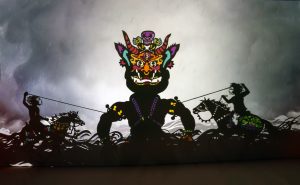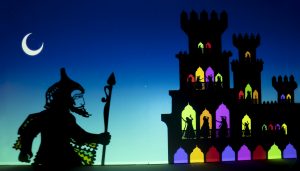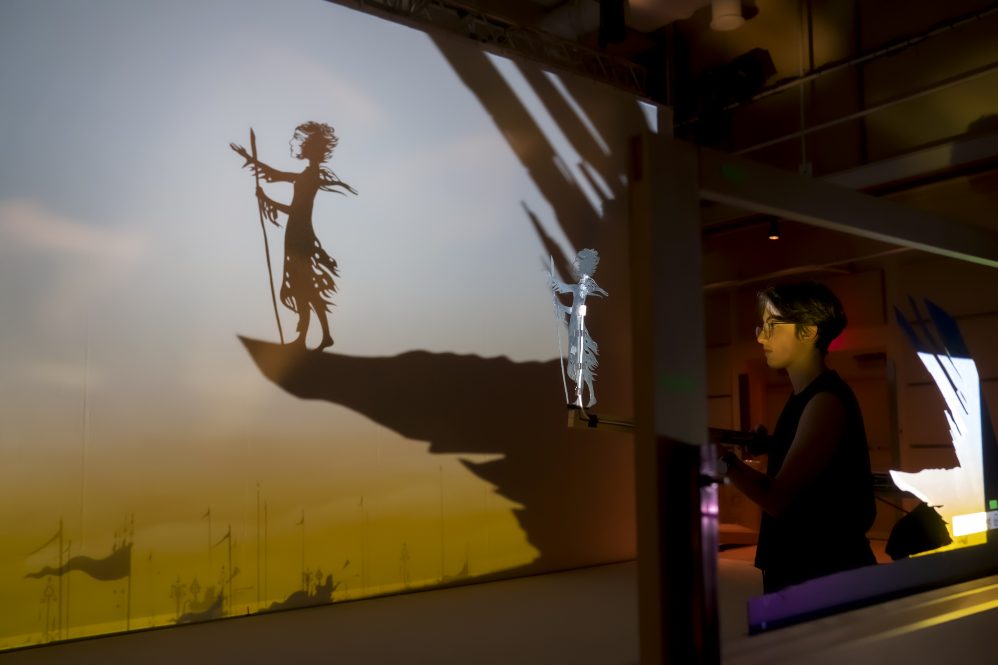Kevin Marinelli sees more from a stack of wood than just a pile of scrap – a runway for a toy airplane, a Roman-style catapult, a box to showcase microscope projections, all grade school projects he built a long time ago from wood lying around his house.
“I’ve always been a tinkerer, since about the age of 3,” says Marinelli, who by day works in the math department as an IT staffer and by night is a puppet fabricator with connections to UConn’s puppet arts program. “I like taking ideas and seeing them become reality.”
They might seem like an unlikely pairing – computers and puppets – but Marinelli says his work as an information technology specialist has allowed him to become the craftsperson he is today.
Hired in 1993 to manage the math department’s computer systems and help graduate students and faculty members with computer graphics, Marinelli’s role now is with the College of Liberal Arts and Sciences and includes server maintenance and specialty lab instrument expertise mostly with mathematics. However, he’s also embedded with a lab in the chemistry department to teach postdocs about the computers systems and hardware that will help them most.
With undergrad and graduate degrees in computer science and chemistry, Marinelli didn’t realize until about a decade ago the wireless data gloves he was designing and building as part of Ph.D. work to draw computer graphics could have a much different application.

He was at the World Maker Faire New York demonstrating the gloves, novel because they work as a pair and allow the user to do things with both hands, when a group of artists suggested the gloves could be used in puppetry – think, wirelessly manipulating the crossbar above a marionette from the wings of a stage.
That remark got him thinking when he returned to work at UConn.
“I spent three months trying to convince Bart Roccoberton, head of the puppet arts program, to let me into his marionette construction class,” Marinelli says. “The marionette performance class is an absolute requirement for students before they take the construction class. It was too late in the semester for me to register for the performance class, but I kept bothering Bart. He made an exception, let me in, and from there, puppets have been a part of my life.”
Marinelli says that since then he’s taken two other puppetry classes, all part of UConn’s MFA program: Paper Sculpture and Materials Techniques, in which he notes he discovered hidden talents like carving wood and sculpting clay.
“Making puppet heads from a drawing was a rather unique assignment in that class,” he says. “You take a drawing from another student, treat it like you’re consulting with them, and then render that drawing into a sculpted figure.
“The person I sculpted for did not like my sculpt,” he admits, “but Bart looked at the drawing and then my sculpt and said they matched. So, the class teaches not just looking at what someone has drawn and interpreting it, but taking an idea and putting it on paper so you can properly communicate to another person what your idea is. Since I come at this from a more technical point of view, the course taught me to better communicate with artists and take their ideas for a project and make them come to reality.”
It’s a lesson used in the real world several years ago when Iranian visual artist Hamid Rahmanian heard of Marinelli skills and contracted with him to laser cut 400 shadow puppets for his show “Song of the North,” which premiered in Paris in 2022 and is making a stop at the Jorgensen Center for the Performing Arts in Storrs on Sept. 21.
Colored gel, gaff tape, and hinges – oh my
Marinelli’s introduction to Rahmanian came via friend and fellow UConn puppeteer Neda Izadi ’20 MFA, who met Rahmanian when his earlier show “Feathers of Fire: A Persian Epic” was touring from 2016-18.
Because she too is an Iranian visual artist with an understanding of the intricate design of traditional Iranian motifs and the nuances of Iranian mythology, Izadi says Rahmanian came looking for her when “Song of the North” was in development.
“I was very enthusiastic to work with Hamid,” Izadi says. “I admire him because few artists want to produce shows based on Iranian epics for an American audience. I did it for my MFA project, and I know how hard it is to make a story understandable for an American audience. Hamid did it successfully and with ‘Song of the North’ makes the audience understand Persian culture a little better.”
Her task, she says, was to take the laser cut shadow puppets that Marinelli cut, add colored gels to give them a touch of beauty, and attach sticks and wires to give them stability – delicate and tedious work.
Marinelli says he first tried to cut the puppets out of a Styrene material with a low molecular weight, but the edges came out looking burnt and that would have affected the shadow projection. He had to shift to a more expensive material, which in the end “cut beautifully.”
Some of the puppets were only a few inches in size, making them among the most difficult to cut, he says, thanks to the fine detailing that needed to be carved out. Izadi agrees, saying the hardest for her were the demons because of their small size.

“Some of the puppets are very fragile. I had to add supports because we knew the puppets would be used for multiple shows and they needed to be strong enough to travel around the world,” Izadi says. “I used mostly gaff tape to attach sticks to the back, and I had to be very careful to follow the curvature of the piece because even the smallest piece of tape sticking out would be visible when projected on a screen 10 times bigger.”
Little details like that are important, she adds, especially when people like former Iranian Queen and Empress Farah Pahlavi are in the audience for the world premiere.
“Hamid has a very keen eye on what he wants,” puppeteer Zach Broome ’18, ’21 MFA says. “Because he was precise on some of the things he wanted, sometimes when we would meet, we would set up the pieces of the puppets on a table, and I’d ask him to place, say, an arm at the highest point he wanted the arm to go and take a photo. Then he’d place it at the lowest position, and I’d take a photo of that to reference later.”
Broome, who connected with Rahmanian through Marinelli, was charged with giving movement to about 50 puppets that needed animation. He says most weren’t complicated, but because he was working on them at home during the pandemic – as opposed to in a workshop with specialized tools – even the simplest was difficult.
“We started out with a spy character, and he needed to run and swing his arms. There were some puppets that had a battering ram, basically a line of four or five guards that have a large log that they ram against a door,” Broome says. “I made a number of versions of Bijan, who is the main protagonist of the show. My favorite one is where he’s being hunted by a bunch of people with spears, and as he’s running, he’s looking to his left and to his right.”
A shadow puppet is a flat cutout that is lit from one side so its shadow can be projected onto a screen and come alive as it dances in the light. Because it’s two dimensional, making a head turn isn’t as easy as it would be with a 3D puppet.
Broome says that for the Bijan puppet that needed to move its head, he drew inspiration from puppeteer Larry Reed, who worked with Rahmanian on previous projects, to develop a type of mask with fins to give the illusion of movement. When the shadow rotates one way it looks like it’s moving in that direction, and the other way to switch.
“Basically, every piece that I got was something that Kevin cut out. All my puppets started out as flat pieces of plastic that we laser cut. My job was to take the various pieces and give them hinges and pivots and things like that so they would get the movement that we needed,” Broome says.
After its Paris opening, “Song of the North” traveled to New York City for its U.S. premiere, then on to South America before returning to the U.S. early this year with shows in Dallas and New York City. The UConn performance kicks off a longer U.S. tour that includes stops in California, Washington, and Pennsylvania.
“If Hamid could find the perfect venue, he could create a show where people would buy two tickets and you would see the show from the audience perspective one night and the next night you would be just as interested to watch the show from behind the scenes because it’s a completely different performance. There’s just a flurry of activity,” Broome says. “It’s mind boggling, even knowing the various tricks they use.”
Marinelli saw the show in New York and says it was amazing to see the puppets he helped create come alive on stage: “Seeing a static two-dimensional object is a beautiful thing, but when you see it performed as a character on stage it goes from beautiful to magical. It was a complete transformation of the art once you do the performing and tell a story.”
“Song of the North,” which will be performed Thursday, Sept. 21, at 7:30 p.m. at the Jorgensen Center for the Performing Arts, also features UConn alums Esme Roszel ’20 (SFA), Ray Dondero ’21 (SFA), and Harrison Greene ’12 (SFA) as part of the performance company. It tells the tale of ancient Persian heroine, Manijeh, in a love story adapted from the Book of Kings (Shahnameh). Tickets are available online.



